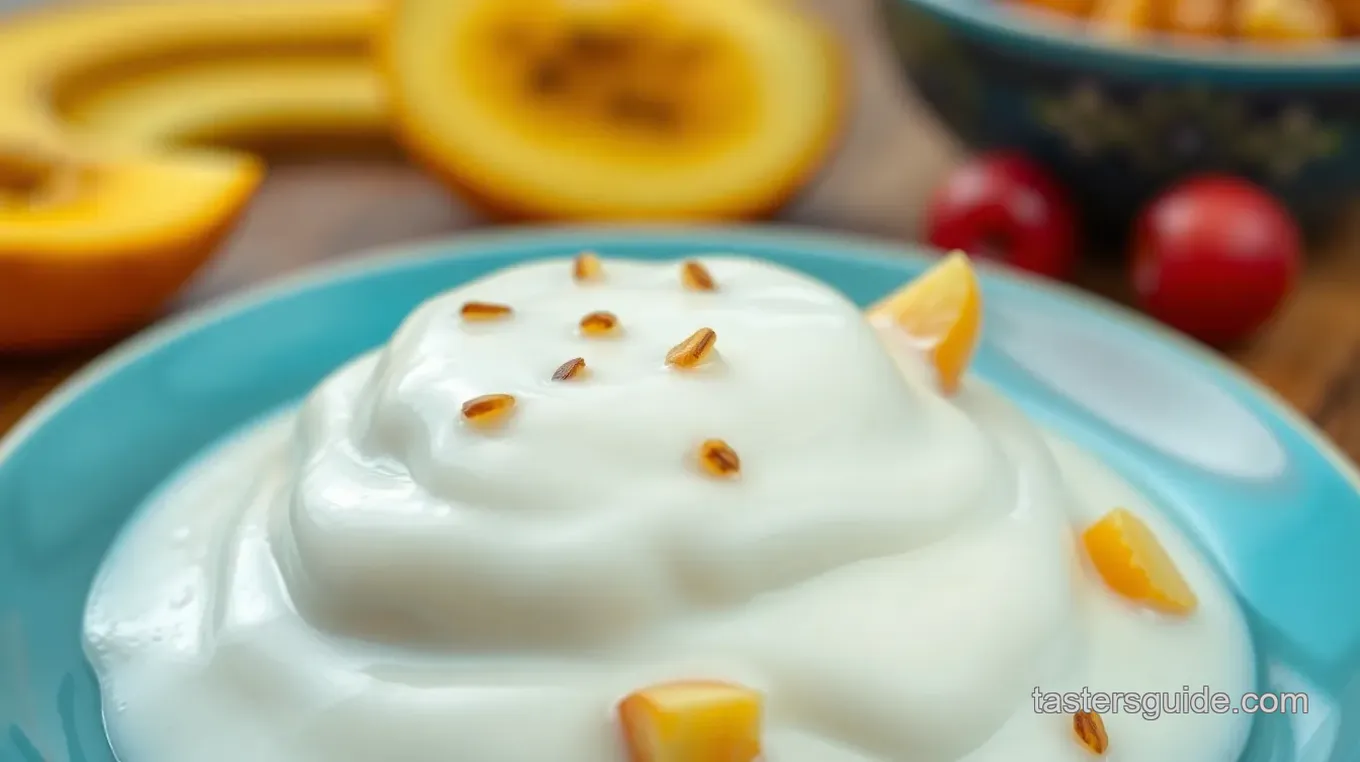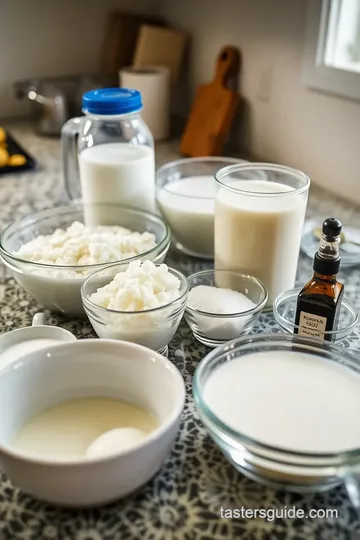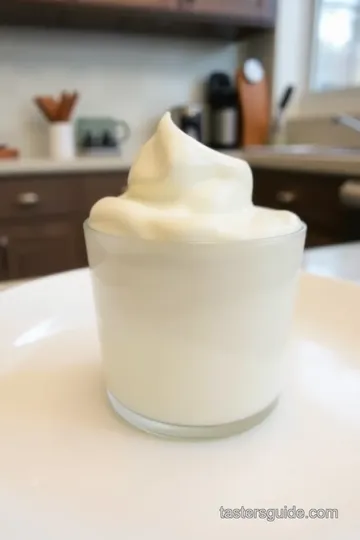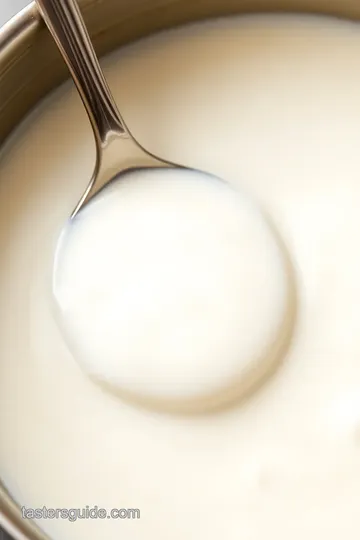Creamy Bliss: Transform Water Kefir into a Delightful Milk Beverage
Discover how to Transform Water Kefir into Creamy Milk Delight with this simple recipe! A refreshing, probiotic beverage you can enjoy anytime.

- Let’s look into into Creamy Bliss: Transform Water Kefir into a Delightful Milk Beverage!
- Unlocking the Essence of Essential Ingredients
- Professional Cooking Method: Mastering the Art of Recipe Transformation
- Pro Tips & Secrets for Your Creamy Delight
- Perfect Presentation
- Storage & Make-Ahead Tips
- Creative Variations
- Complete Nutrition Guide
- Frequently Asked Questions
- Recipe Card
Let’s look into into Creamy Bliss: Transform Water Kefir into a Delightful Milk Beverage!
Have you ever sipped on something and felt an instant wave of refreshment? picture this: you’re cranking up the heat in the kitchen, and the sun is blazing outside.
You want something cool, refreshing, and a tad indulgent. what pops into my head? transforming water kefir into a creamy delight.
Yep, water kefir! this funky, fizzy drink has more to offer than just its probiotic benefits. grab your blender, dive in with me, and let’s create a luscious milk beverage that’s perfect for any time of day.
A Journey Through History
Water kefir is no stranger to our diets. it dates back hundreds of years, steeped in the traditions of fermentation.
People across different cultures have enjoyed this bubbly drink, reaping the health benefits of its probiotic magic. nowadays, it’s a star in the health community.
It’s become quite the trend, especially among fans of fermented drinks. but wait—it doesn’t stop at just drinking it straight! you can actually blend it up with a little milk (or any alternative milk) to create something that feels oh-so-decadent.
Easy-Peasy and Worth It!
Ready to dive into some numbers? the process involves minimal effort— 10 minutes of prep time followed up by a 24-hour fermentation session.
That’s right, you just blend and then let it chill. perfect for beginners! it's a breeze, and you'll yield about four servings.
Plus, when it comes to costs, you're looking at a low-budget gem. whole ingredients and maybe a little honey? you can't beat that!
Why You’ll Love This Recipe
Now, let’s talk health. the benefits of water kefir are stellar! you're sipping on a drink that not only tastes amazing but also gives your gut a boost.
Probiotic beverages like this are genius for intestinal health . it’s low-calorie and can easily become one of your go-to refreshing summer drinks.
Want to impress guests? serve this up at brunch, and they'll be asking for your homemade kefir recipes. trust me, they will!
The Creativity Factor
One of the coolest things about this recipe? you can experiment with flavors! add some cocoa for a chocolate twist or echo summer sweetness with fresh berries.
Gone are those ordinary smoothies; we’re talking about crafting creamy kefir milkshakes like a pro! plus, it's adaptable, meaning if you’re craving a vegan option, you can totally swap those dairy ingredients out.
Blend away with almond milk or coconut milk—whatever tickles your fancy!
So, are you ready to explore ingredients? Let's get to the nitty-gritty and see how we create this amazing, fizz-filled milk delight that won't just quench your thirst, but will turn every sip into a celebration!

Unlocking the Essence of Essential Ingredients
When it comes to whipping up delicious goodies, knowing your essential ingredients is half the battle. seriously, it’s true! you can whip up something fantastic with the right tools and know-how.
Here’s the lowdown on what you need to get started, so let’s dive in!
Premium Core Components
Let’s get down to business. The first step is to familiarize yourself with some premium core components . You’re going to want details like detailed measurements for both US and metric, so everyone can get in on the cooking fun!
-
Quality indicators : for example, look for fresh berries that are plump and colorful, not shriveled. and if you’re buying spices, check that they have a strong aroma.
That tells you they’re fresh and ready to flavor your meals.
-
Storage guidelines : did you know that some ingredients like spices can lose their flavor if stored poorly? keep them in airtight containers, away from light.
Most spices are good for about six months , but you can test their freshness by smelling them.
-
Freshness Tips : Always, and I mean always, look for seasonal ingredients. They are fresher, tastier, and better for your wallet. Check local farmers' markets if you can!
Signature Seasoning Blend
Now onto the fun stuff—seasoning! A good seasoning blend can elevate your dish from “meh” to “wow!” Remember, it's all about the essential spice combinations .
-
Mix a pinch of paprika with a dash of garlic powder and some dried oregano for a great all-purpose blend.
-
You can also play around with herb selections and pairings . Basil pairs beautifully with tomatoes, while dill and cucumber make a delightful duo.
Smart Substitutions
Ever find yourself at the grocery store, ready to whip up a dish, only to realize you're missing an ingredient? No worries—here's where smart substitutions come into play!
-
Common Alternatives : If you’re out of eggs, use unsweetened applesauce (1/4 cup = 1 egg) for baking. Trust me; it works like a charm!
-
Looking to be a bit healthier? Try dietary modifications , like using Greek yogurt instead of sour cream in recipes. It’s lower in fat and boosts your protein intake!
-
If you’re caught without an ingredient, keep a mental list of emergency replacements . No flour? Use ground oats for a gluten-free option!
Kitchen Equipment Essentials
Alright, we've talked ingredients—now let’s chat about the tools! There are some must-have tools that every home cook should own.
-
A good chef's knife is a game-changer. it makes prep work a breeze. if you don’t have one, a sturdy pairing knife would do, but let’s be honest, you’ll want that chef's knife.
-
And don’t forget about alternative equipment options ! If you don’t have a blender, a food processor can also whip up those smoothies or sauces just fine.
Finally, let’s throw in some prep tips —if you prep your veggies ahead of time, you’ll speed up your whole cooking session. Trust me; it’s a lifesaver!
Transitioning to the Good Stuff
At this point, you should have a good grip on what you need to start cooking up a storm! So now it’s time to get into the nitty-gritty of some amazing recipes.
Speaking of recipes, have you ever wanted to transform water kefir into a creamy milk delight ? this innovative drink capitalizes on the probiotic benefits of water kefir, then combines it with the creamy goodness of milk to deliver a beverage you’ll want to enjoy at any time of the day.
You'll quickly see how these creamy beverage recipes can be your go-to for healthy hydration options or even as a base for those luscious kefir milkshakes ! Can’t wait to share my easy-to-follow steps? Me either! Let’s kick off the fun part where you get to experiment in the kitchen!

Professional Cooking Method: Mastering the Art of Recipe Transformation
Hey there, fellow food lovers! let’s dive into a journey of flavors as we transform water kefir into a creamy milk delight .
Not only does this process yield a deliciously unique drink, but it also unlocks a world of benefits . trust me, if you’ve never tried making your own homemade milk alternatives , you’re in for a treat! we'll walk through essential steps, expert techniques, and success strategies.
Time to pop on that apron and get cooking!
Essential Preparation Steps
Alright, let’s kick this off with mise en place . this fancy french term just means getting everything ready to go.
Gather your ingredients: 2 cups of water kefir, 1 cup of whole milk (or your fave non-dairy option), honey, and vanilla extract.
Having everything prepped really speeds up the process and gives you fewer headaches later.
Now, onto time management . if you’re like me, you sometimes lose track of time while cooking. set a timer for 24 hours after you mix everything up — it’s crucial for the fermentation process.
Don’t forget to have some snacks on hand for when hunger strikes during this waiting game!
Being organized is key in the kitchen. keep your workspace clean and all your utensils in their place. trust me, it makes cooking way less chaotic.
And let’s not forget safety — wash your hands and any surfaces that come into contact with raw ingredients. nobody likes a surprise food-borne illness, am i right?
Step-by-Step Process
Here’s where things get fun! Let’s break it down with clear, numbered instructions.
- Prepare Water Kefir : If you have your own kefir grains, strain them to get 2 cups of liquid.
- Combine Ingredients : In a mixing bowl, whisk together the water kefir, 1 cup of milk, 1 tablespoon of honey, and 1 teaspoon of vanilla extract. Mix until it's all blended — no lumps allowed!
- Ferment the Mixture : Pour your mixture into an airtight container, but don’t seal it completely. Let it hang out at room temp for 24 hours so it can ferment. You might want to check it and taste it after 24 hours ; if you prefer it tangier, leave it for a few extra hours.
- Chill and Serve : Once it’s fermented just right, shake it up, chill it for at least 2 hours , then pour it over ice and garnish with fresh berries.
This process is so simple, even beginners can nail it! i remember the first time i tried making kefir. i was excited but a bit intimidated.
Honestly, it turned out great and became a go-to recipe!
Expert Techniques
Now let’s spice things up a bit with some expert techniques . if your drink isn’t as creamy as you'd like, the trick is to experiment with different milks .
Almond, oat, or even coconut could totally change the game.
Another important step is monitoring temperature. Ideally, you should keep that mixture in a room that’s between 68° F and 72° F . This range is where fermentation thrives!
Don’t forget to create quality checkpoints . After fermentation, take a small taste. Does it need another hour? Go for it!
Troubleshooting Tips
If your kefir isn’t bubbling, it might be too cold or the grains need more sugar water to thrive. Don’t stress! Every kitchen has its quirks, and cooking is all about experimenting.
Success Strategies
Let’s talk about a few common mistakes to avoid . Make sure the fermenting container is clean! A dirty container can lead to funky flavors — yikes!
For quality assurance , always taste along the way and adjust ingredients as needed. Love a sweeter drink? Toss in a little more honey or switch to natural sweeteners like agave nectar.
Lastly, let’s consider make-ahead options . you can prep your base and let it ferment a day or two ahead of when you plan to serve it.
Besides saving you time, it’s also a great way to ensure that you serve a refreshing summer drink whenever you want!
And there you have it, a delightful way to transform water kefir into a creamy milk delight .
As we wrap it up, just remember, making this drink doesn’t just fill your cup; it opens you up to a variety of healthy smoothies , fermented drinks , and creative beverage options.
Now, dive into the world of additional information and start your journey into this scrumptious transformation!

Pro Tips & Secrets for Your Creamy Delight
Honestly, if you’re diving into this transform water kefir into creamy milk delight journey, there are a few tricks that could make it super smooth—both in texture and in timing.
First off, use fresh water kefir grains for the best taste. i once let mine sit a bit too long, and boy, did it turn funky! if you’re short on time, you can always grab store-bought water kefir.
When it comes to speeding things up, a blender is your best friend. you can whip up your milk and kefir mix in a jiffy! don’t forget to check on the fermentation after about 24 hours.
If you want it tangier, let it sit longer. but really, it's all about that personal preference , right?
For flavor enhancements, a splash of vanilla extract does wonders. it’ll add warmth that’ll make you wish you had a cozy blanket on while sipping.
And remember, presentation is key! serve this in a tall glass with a mint sprig or even float some berries on top.
You'll impress your friends while also nailing that refreshing summer drink vibe.
Perfect Presentation
Let’s chat about plating techniques . now, this isn’t a michelin-star restaurant, but we can make it look instagram-worthy, right? layering your creamy milk delight with some fresh berries creates a vibrant look.
Think about color combos—green mint, vibrant blueberries, maybe even a swirl of honey on top.
Garnishing is where you can let your inner artist shine! a sprinkle of cinnamon or nutmeg not only looks pretty but gives a hint of spice as you sip.
And to really make it pop, consider a chic straw or even a cute little drink umbrella if you’re feeling cheeky.
Just remember, we eat with our eyes first !
Storage & Make-Ahead Tips
If you’re planning to enjoy your creamy beverage later, store it in an airtight glass jar. it'll keep in the fridge for about 3-4 days .
I once made a ton and had to drink it all in one go because it sat out too long and turned frothy.
Yikes! as for reheating, you can’t really do that here—since it’s about that cool, creamy vibe. but don’t fret! just shake it up and serve it chilled over ice.
Creative Variations
Now let’s talk about getting creative because honestly, the opportunities here are endless! you could pop in a scoop of cocoa powder for a chocolatey twist.
I experimented with a berry smoothie version once, and oh my gosh, it was like a festival of flavors in my mouth!
If you’re on a dairy-free journey, explore using almond or coconut milk instead. and for those with sweet tooth cravings, natural sweeteners like agave nectar can give it that perfect kick without being too overpowering.
Trust me, experimenting will become your new favorite pastime.
Complete Nutrition Guide
Now, before i let you go, let’s break down the nutrition a bit. each serving clocks in at about 130 calories , with 4g of protein.
It's also packed with probiotic benefits from the kefir, which makes it an easy and delicious way to maintain good intestinal health —hello, happy tummy!
When thinking about portions, one cup generally works for most. but honestly? listen to your body. if you want more, who’s stopping you? you can always adjust and make it work for your lifestyle.
In conclusion, dive into this recipe as a fun way to incorporate homemade probiotic drinks into your routine. experiment, have fun with flavors, and watch how this delightful transformation becomes your go-to creamy beverage.
Who knew turning water kefir into a luscious drink could be this easy? enjoy every sip, my friend!
Frequently Asked Questions
How do I Transform Water Kefir into Creamy Milk Delight?
To transform water kefir into a creamy milk delight, simply combine 2 cups of water kefir with 1 cup of whole milk (or a milk alternative), add honey or maple syrup, and vanilla extract. Whisk the mixture until smooth, and then let it ferment for 24 hours before chilling and serving.
What are some tips for achieving the best flavor in my kefir cream beverage?
To enhance the flavor, try using fresh, high-quality ingredients. Experiment with milk types—for instance, whole milk provides more creaminess, while almond or coconut milk can add unique flavors. Additionally, adjusting the amount of sweetener will allow you to customize the drink to your taste.
Can I store leftovers of the creamy milk delight?
Yes, you can store any leftovers in an airtight container in the refrigerator. It's best to consume the beverage within 3 days for optimum taste and freshness, as the fermentation process continues even when chilled.
Are there any variations I can make to the recipe?
Definitely! You can adopt various variations, such as adding cocoa powder for a chocolate twist or incorporating fresh fruits like bananas or mangoes for added sweetness. For a tropical flair, try adding flavored extracts like coconut or almond.
Is this recipe suitable for people with dietary restrictions?
This recipe can be easily adapted for various dietary needs. You can use dairy-free milk alternatives and substitute honey with maple syrup for a vegan option. Adjust the ingredients according to your preferences to suit dietary restrictions.
What are the health benefits of consuming water kefir?
Water kefir is rich in probiotics, which can support gut health and improve digestion. It also contains vitamins and minerals, making it a nutritious addition to your diet. By transforming it into a creamy milk delight, you get the added benefits of calcium and protein from the milk.
Creamy Bliss: Transform Water Kefir into a Delightful Milk Beverage Card

⚖️ Ingredients:
- 2 cups (480ml) water kefir (homemade or store-bought)
- 1 cup (240ml) whole milk (or alternative milk of choice, e.g., almond, coconut)
- 1 tablespoon (15ml) honey or maple syrup (adjust to taste)
- 1 teaspoon (5ml) vanilla extract
- Fresh berries (e.g., strawberries, blueberries) for garnish
- A sprinkle of cinnamon or nutmeg for garnish
- Mint leaves for garnish
🥄 Instructions:
- Step 1: If using homemade water kefir, strain the kefir grains from the liquid to obtain 2 cups of kefir.
- Step 2: In a mixing bowl, whisk together the water kefir, milk, honey (or maple syrup), and vanilla extract until well blended.
- Step 3: Pour the mixture into an airtight glass jar or bottle and seal it loosely. Let it sit at room temperature for 24 hours to allow fermentation.
- Step 4: After fermentation, shake gently and refrigerate the mixture for at least 2 hours before serving. Serve over ice, garnished with fresh berries and a sprinkle of cinnamon or nutmeg if desired.
Previous Recipe: How to Make Sizzling Stir-Fried Chicken with Veggies: 5 Easy Tips!
Next Recipe: Quick & Flavorful Grill Flank Steak Tacos: My Family's Favorite Recipe
